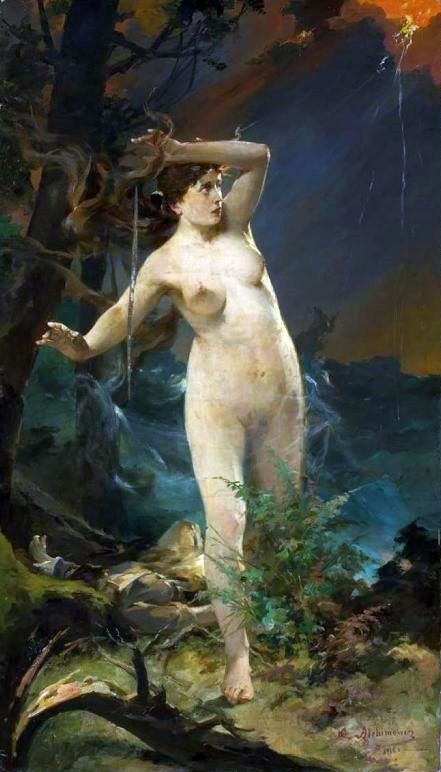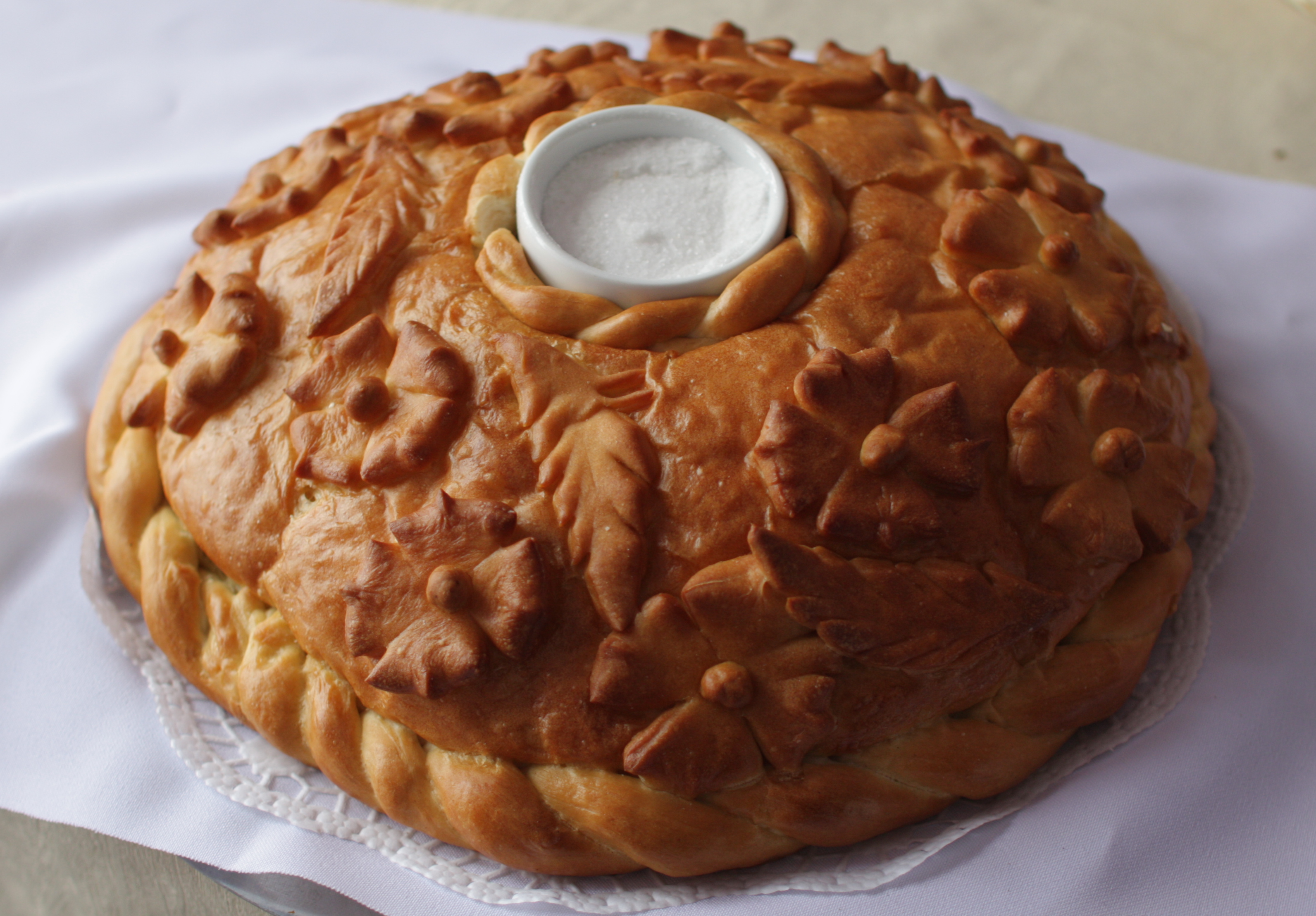|
Gabija
Gabija (also known as Gabieta, Gabeta) is the spirit of the fire in Lithuanian mythology. She is the protector of home and family. Her name is derived from ''gaubti'' (to cover, to protect) or from St. Agatha (, Gafiya). Gabija is only mentioned in a list of Lithuanian gods by the Christian theologian Jan Łasicki in his treatise on idolatry (published in 1615). She is found in Lithuanian folklore. Gabija could take zoomorphic forms of a cat, stork or rooster, or she could appear as a woman clothed in red. Gabija was greatly respected and cared for like a living creature. People would feed Gabija by offering bread and salt. Fire had to be laid to bed – women would cover the charcoal with ashes every evening so that fire would not wander around. Just as Gabija was the protector of the house, mother of the household was the protector of fire. Sometimes a bowl of clean water would be left near the hearth so that Gabija could wash herself. If angered, Gabija would "go for a wal ... [...More Info...] [...Related Items...] OR: [Wikipedia] [Google] [Baidu] |
List Of Lithuanian Gods And Mythological Figures
The list of Lithuanian gods is based on scarce written sources and late folklore. Many of them were outright invented. Lithuania converted to Christianity in 1387, but elements of Lithuanian mythology survived into the 19th century. The earliest written sources, authored by foreigners and Christians, only briefly mention the Lithuanian gods. Beginning in the 16th century, the pagan religion received more attention from authors, but often their accounts were confused, contradictory, and heavily influenced by various religious agendas. Collection and recording of folklore began in the 19th century, by which time the pagan mythology had become fragmented and mixed with Christian traditions. The cults of old deities transformed into folklore (individual tales, myths, songs, etc.) without associated rituals. Because of such difficulties obtaining data, there is no accepted list of Lithuanian gods. Different authors present wildly contradictory reconstructions of the Lithuanian pantheo ... [...More Info...] [...Related Items...] OR: [Wikipedia] [Google] [Baidu] |
Lithuanian Mythology
Lithuanian mythology () is the mythology of Lithuanians, Lithuanian polytheism, the religion of pre-Christian Lithuanians. Like other Indo-European studies, Indo-Europeans, Lithuanians (tribe), ancient Lithuanians maintained a polytheistic mythology and religious structure. In pre-Christian Lithuania, mythology was a part of polytheistic religion; after Christianisation mythology survived mostly in folklore, customs and festive rituals. Lithuanian mythology is very close to the mythology of other Balts, Baltic nations such as Old Prussians, Prussians and Latvians, and is considered a part of Baltic mythology. Sources and evidence Early Lithuanian religion and customs were based on oral tradition. Therefore, the very first records about Lithuanian mythology and beliefs were made by travellers, Christian missionaries, chronicle writers and historians. Original Lithuanian oral tradition partially survived in national ritual and festive songs and legends which started to be writ ... [...More Info...] [...Related Items...] OR: [Wikipedia] [Google] [Baidu] |
Nëna E Vatrës
Nëna e Vatrës or Nana e Votrës ("The Mother of the Hearth") is an Albanian mythological figure, the protector of the hearth (), associated with the household fire worship, the cult of the ancestor and family life. She is sometimes regarded as a goddess (''hyjni e zjarrit të vatrës'' "deity of the hearth fire") in Albanian traditions. Names and etymology Nëna e Vatrës is a mythological figure of the hearth fire commonly found in the folk beliefs of the Albanians, thus there are many dialectal variations, singular or plural: ''Nëna e Vatrës/Nana e Votrës'', ''E Ëma e Vatrës/E Ama e Votrës'', ''Mëma e Vatrës/Mama e Vatrës'', ''Shtriga e Vatrës/Votrës'', ''Plaka e Vatrës/Votrës'', ''Mëmat e Vatrës/Mamat e Votrës'', ''Xhuxhet e Vatrës'' etc. The first element ''nënë/nanë'' or ''ëmë/amë'', means "mother"; while the last element ''vatër/votër'', means "hearth", "fireplace", and is related to the Avestan ''atar'', "fire". Folk beliefs In Albanian folk b ... [...More Info...] [...Related Items...] OR: [Wikipedia] [Google] [Baidu] |
Fire
Fire is the rapid oxidation of a fuel in the exothermic chemical process of combustion, releasing heat, light, and various reaction Product (chemistry), products. Flames, the most visible portion of the fire, are produced in the combustion reaction when the fuel reaches its ignition point temperature. Flames from hydrocarbon fuels consist primarily of carbon dioxide, water vapor, oxygen, and nitrogen. If hot enough, the gases may become ionized to produce Plasma (physics), plasma. The color and Intensity (heat transfer), intensity of the flame depend on the type of fuel and composition of the surrounding gases. Fire, in its most common form, has the potential to result in conflagration, which can lead to permanent physical damage. It directly impacts land-based ecological systems worldwide. The positive effects of fire include stimulating plant growth and maintaining ecological balance. Its negative effects include hazards to life and property, atmospheric pollution, and water ... [...More Info...] [...Related Items...] OR: [Wikipedia] [Google] [Baidu] |
Agatha Of Sicily
Agatha of Sicily () is a Christian saint. Her feast is on 5 February. Agatha was born in Catania, part of the Roman Province of Sicily, and was martyred . She is one of several virgin martyrs who are commemorated by name in the Canon of the Mass. Agatha is the patron saint of Catania, Molise, Malta, San Marino, Gallipoli in Apulia, and Zamarramala, a municipality of the Province of Segovia in Spain. She is also the patron saint of breast cancer patients, rape victims, martyrs, wet nurses, bell-founders, and bakers, and is invoked against fire, earthquakes, and eruptions of Mount Etna. Early history Agatha is buried at the Badia di Sant'Agata, Catania. She is listed in the late-6th-century associated with Jerome, and the , the calendar of the church of Carthage, . Agatha also appears in one of the of Venantius Fortunatus. Two early churches were dedicated in her honor in Rome, Sant'Agata in Trastevere and notably the Church of Sant'Agata dei Goti in Via Mazzarino, a tit ... [...More Info...] [...Related Items...] OR: [Wikipedia] [Google] [Baidu] |
Jan Łasicki
Jan Łasicki (; 1534–1602) was a Polish historian and theologian. He was well-educated and traveled extensively in Western Europe from 1556 to 1581. Around 1557 he converted to Calvinism, becoming a follower of the Unity of the brethren in 1567. His major work is eight-volume ''Historia de origine et rebus gestis fratrum Bohemicorum''. The Only one volume survives which deals with customs and organizations of the brethren and was first published in 1660. His other works include ''Historia de ingressu Polonorum in Valachiam cum Bogdano'' (1584) about the Polish invasion of Wallachia. The work was translated into Polish by Władysław Syrokomla in 1855. His 18-page ''Concerning the gods of Samagitians, and other Sarmatians and false Christians'' (''De diis Samagitarum caeterorumque Sarmatarum et falsorum Christianorum'', written and published in 1615) provides a list of Lithuanian gods and is an important resource in the study of the Lithuanian mythology Lithuanian mythol ... [...More Info...] [...Related Items...] OR: [Wikipedia] [Google] [Baidu] |
Idolatry
Idolatry is the worship of an idol as though it were a deity. In Abrahamic religions (namely Judaism, Samaritanism, Christianity, Islam, and the Baháʼí Faith) idolatry connotes the worship of something or someone other than the Abrahamic God as if it were God. In these monotheistic religions, idolatry has been considered as the "worship of false gods" and is forbidden by texts such as the Ten Commandments. Other monotheistic religions may apply similar rules. For instance, the phrase '' false god'' is a derogatory term used in Abrahamic religions to indicate cult images or deities of non-Abrahamic Pagan religions, as well as other competing entities or objects to which particular importance is attributed. Conversely, followers of animistic and polytheistic religions may regard the gods of various monotheistic religions as "false gods" because they do not believe that any real deity possesses the properties ascribed by monotheists to their sole deity. Atheists, who do n ... [...More Info...] [...Related Items...] OR: [Wikipedia] [Google] [Baidu] |
Folklore
Folklore is the body of expressive culture shared by a particular group of people, culture or subculture. This includes oral traditions such as Narrative, tales, myths, legends, proverbs, Poetry, poems, jokes, and other oral traditions. This also includes material culture, such as traditional building styles common to the group. Folklore also encompasses customary lore, taking actions for folk beliefs, including folk religion, and the forms and rituals of celebrations such as Christmas, weddings, folk dances, and Rite of passage, initiation rites. Each one of these, either singly or in combination, is considered a Cultural artifact, folklore artifact or Cultural expressions, traditional cultural expression. Just as essential as the form, folklore also encompasses the transmission of these artifacts from one region to another or from one generation to the next. Folklore is not something one can typically gain from a formal school curriculum or study in the fine arts. Instead, thes ... [...More Info...] [...Related Items...] OR: [Wikipedia] [Google] [Baidu] |
Zoomorphic
The word ''zoomorphism'' derives from and . In the context of art, zoomorphism could describe art that imagines humans as non-human animals. It can also be defined as art that portrays one species of animal like another species of animal or art that uses animals as a visual motif, sometimes referred to as "animal style". Depicting deities in animal form (theriomorphism) is an example of zoomorphism in a religious context. It is also similar to the term Shapeshifting, therianthropy; which is the ability to shape shift into animal form, except that with zoomorphism the animal form is applied to a physical object. It means to attribute animal forms or animal characteristics to other animals, or things other than an animal; similar to but broader than anthropomorphism. Contrary to anthropomorphism, which views animal or non-animal behavior in human terms, zoomorphism is the tendency of viewing human behavior in terms of the behavior of animals. It is also used in literature to portray ... [...More Info...] [...Related Items...] OR: [Wikipedia] [Google] [Baidu] |
Bread And Salt
Bread and salt are offered to guests in a ceremony of welcome in cultures around the world. This pair of foods is particularly significant in Slavs, Slavic countries, but is also notable in Nordic race, Nordic, Balts, Baltic, Balkan and other European cultures as well as in Middle Eastern cultures. Bread and salt as a traditional greeting remains common in Albania, Armenia, and among the Jewish diaspora. This tradition has been extended to human spaceflight, spaceflight. Additionally, in traditional Slavic paganism, Slavic folklore, consuming a combination of bread and salt as an offering is believed to be a powerful, last-resort method of wish-making. Background Salt is an essential nutrient, and has long held an important place in religion and culture. For example, Salt in the Bible, it is mentioned in the Bible dozens of times, including as a covenant of salt. Bread is a staple food, Leavening agent, leavened or unleavened. It is usually made of wheat, but other grains c ... [...More Info...] [...Related Items...] OR: [Wikipedia] [Google] [Baidu] |
Microbiology
Microbiology () is the branches of science, scientific study of microorganisms, those being of unicellular organism, unicellular (single-celled), multicellular organism, multicellular (consisting of complex cells), or non-cellular life, acellular (lacking cells). Microbiology encompasses numerous sub-disciplines including virology, bacteriology, protistology, mycology, immunology, and parasitology. The organisms that constitute the microbial world are characterized as either prokaryotes or eukaryotes; eukaryote, Eukaryotic microorganisms possess membrane-bound organelles and include fungi and protists, whereas prokaryote, prokaryotic organisms are conventionally classified as lacking membrane-bound organelles and include Bacteria and Archaea. Microbiologists traditionally relied on culture, staining, and microscopy for the isolation and identification of microorganisms. However, less than 1% of the microorganisms present in common environments can be cultured in isolation using c ... [...More Info...] [...Related Items...] OR: [Wikipedia] [Google] [Baidu] |









